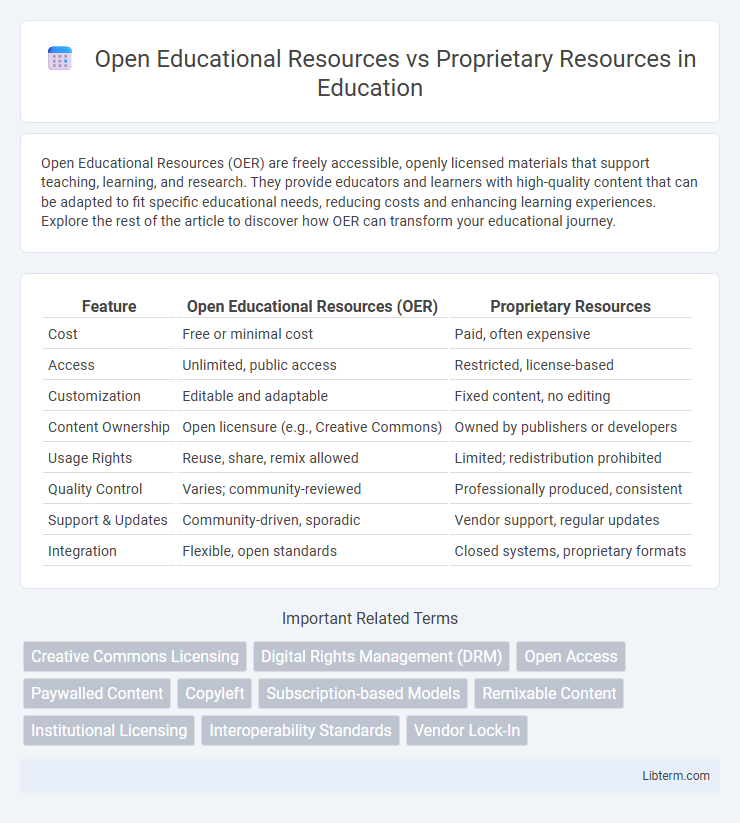Open Educational Resources (OER) are freely accessible, openly licensed materials that support teaching, learning, and research. They provide educators and learners with high-quality content that can be adapted to fit specific educational needs, reducing costs and enhancing learning experiences. Explore the rest of the article to discover how OER can transform your educational journey.
Table of Comparison
| Feature | Open Educational Resources (OER) | Proprietary Resources |
|---|---|---|
| Cost | Free or minimal cost | Paid, often expensive |
| Access | Unlimited, public access | Restricted, license-based |
| Customization | Editable and adaptable | Fixed content, no editing |
| Content Ownership | Open licensure (e.g., Creative Commons) | Owned by publishers or developers |
| Usage Rights | Reuse, share, remix allowed | Limited; redistribution prohibited |
| Quality Control | Varies; community-reviewed | Professionally produced, consistent |
| Support & Updates | Community-driven, sporadic | Vendor support, regular updates |
| Integration | Flexible, open standards | Closed systems, proprietary formats |
Introduction to Educational Resources
Open Educational Resources (OER) provide free, accessible, and adaptable teaching materials that promote equitable learning opportunities by allowing educators to modify content to meet diverse needs. Proprietary resources often require purchase or subscription, limiting access and flexibility but typically offering curated, professionally developed content with dedicated support services. The choice between OER and proprietary resources significantly impacts educational equity, cost efficiency, and the ability to customize curriculum for different learner populations.
Defining Open Educational Resources (OER)
Open Educational Resources (OER) are freely accessible, openly licensed teaching, learning, and research materials that can be legally used, shared, and modified by anyone. Unlike proprietary resources, OER empower educators and learners with adaptability and cost-efficiency, fostering inclusive education and innovation. These resources include textbooks, videos, assessments, and curricula designed to expand educational access globally.
Understanding Proprietary Educational Resources
Proprietary educational resources are created, owned, and controlled by private entities or organizations, requiring users to obtain licenses or pay fees for access. These resources often include textbooks, software, and course materials tailored with exclusive rights to distribution and modification, limiting free use and adaptation. Understanding the proprietary nature highlights issues of cost barriers and restricted access compared to open educational resources (OER), which are freely available and designed for wide dissemination and customization.
Accessibility and Availability
Open Educational Resources (OER) offer unrestricted access and free availability online, enabling learners worldwide to utilize and adapt materials without cost barriers. Proprietary resources often require paid subscriptions or licenses, limiting accessibility to those who can afford them and restricting availability across diverse educational contexts. The open licensing of OER enhances equitable access and continuous availability, fostering inclusive education and lifelong learning opportunities globally.
Cost Comparison: Free vs Paid Content
Open Educational Resources (OER) offer free access to high-quality educational materials, significantly reducing costs for students and institutions compared to proprietary resources, which often require expensive licenses or subscriptions. Proprietary resources may provide specialized content and technical support but impose recurring fees that can limit accessibility and scalability. The cost savings from OER enable wider adoption and equitable learning opportunities without compromising educational quality.
Flexibility and Customization Options
Open Educational Resources (OER) provide unmatched flexibility and customization options, allowing educators to adapt content to specific learning needs and update materials freely. Proprietary resources often come with fixed formats and limited modification rights, restricting educators' ability to tailor content. This inherent adaptability of OER supports diverse teaching styles and evolving curriculum requirements more effectively.
Quality and Credibility of Content
Open Educational Resources (OER) often undergo peer review and are developed collaboratively by educators and experts, enhancing their quality and credibility through transparency and continuous updates. Proprietary resources may have strict editorial processes and professional authorship, but their quality can vary widely and access is limited by licensing, potentially restricting content validation and peer feedback. The credibility of OER is strengthened by open licensing that allows for content adaptation and improvement, while proprietary resources rely heavily on brand reputation and publisher vetting for trustworthiness.
Intellectual Property and Licensing
Open Educational Resources (OER) are typically licensed under Creative Commons or similar licenses that allow free use, modification, and distribution, promoting collaborative knowledge sharing and educational innovation. Proprietary resources are protected by traditional copyright laws, restricting access, modification, and redistribution, which limits flexibility and incurs licensing fees. The contrasting intellectual property frameworks influence cost, accessibility, and adaptability in educational settings.
Impact on Teaching and Learning
Open Educational Resources (OER) enhance teaching and learning by providing free, adaptable content that supports personalized instruction and fosters collaboration among educators and students. Proprietary resources often limit access due to high costs and restrictive licenses, which can hinder curriculum flexibility and equitable learning opportunities. The widespread adoption of OER contributes to improved educational outcomes by enabling diverse, context-specific materials that accommodate various learning styles and promote active engagement.
Future Trends in Educational Resource Adoption
Open Educational Resources (OER) are expected to dominate future educational landscapes due to their cost-effectiveness, adaptability, and ease of access, fostering inclusive and personalized learning environments. Proprietary resources may continue to evolve with augmented reality and AI-driven content designed for niche expertise, but often face barriers related to licensing and affordability. The increasing integration of data analytics will enhance the customization of both OER and proprietary materials, with institutions likely favoring hybrid models that combine openness with specialized proprietary innovation.
Open Educational Resources Infographic

 libterm.com
libterm.com